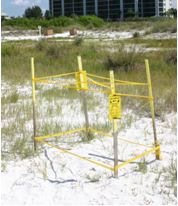Turtle Time
Have you noticed four yellow stakes on the beach tied together with yellow flagging tape? These “cages” are erected to protect sea turtle nests during nesting season, which runs from May 1-October 31.
A female turtle can lay several nests during one season and only nests every two or three years. The hard process of nesting takes hours. A turtle must drag her massive weight out of the water to the dunes. She uses her back flippers to dig a hole and deposits about one hundred rubbery eggs, each the size of a ping-pong ball. The turtle disguises the nest by flinging sand over it. Once she leaves the nest, she never returns.
Mote Marine Laboratory has begun its 34th year of monitoring sea turtle nesting along 35 miles of local beaches. Throughout nesting season, Mote scientists, interns and more than 300 volunteers in Mote’s Sea Turtle Patrol document nesting every day from Longboat Key through Venice.
This year, Mote’s Sea Turtle Conservation and Research Program will continue its long-term studies of local sea turtles by documenting every sea turtle nest and false crawl (when a turtle emerges but does not leave a nest) in Mote’s patrol area, marking each nest with yellow stakes and flagging tape and collecting scientific data about each nest when it is found.
During this time of increased local nesting, it is critically important that the public supports sea turtle research and conservation.
TIPS FOR THE PUBLIC: BOATING, BEACH LIGHTING AND MORE
During nesting season, it is important to keep local waters and beaches sea-turtle friendly.
Sea turtles are swimming just offshore to mate before the females come ashore to nest, juvenile turtles are feeding along the Gulf Coast, and by early summer the first hatchlings will venture into Gulf waters. So far this year, Mote has recovered several sea turtles suspected to have been struck by boats, entangled in fishing gear or otherwise affected by human interaction.
On the nesting beaches, light from waterfront properties can disorient nesting female turtles and their young, which emerge at night and use dim natural light to find the sea. Also, beach furniture, trash and other obstacles can impede sea turtles and their young.
Mote encourages coastal residents and visitors to follow the turtle-friendly tips below during nesting season, May 1 – Oct. 31.
On shore
Do:
• If you encounter a nesting turtle or hatchlings, remain quiet and observe from a distance.
• Shield or turn off outdoor lights that are visible on the beach from May through October.
• Close drapes after dark and stack beach furniture at the dune line or, ideally, remove it from the beach.
• Fill in holes that may entrap hatchlings on their way to the water.
Do Not:
• Approach nesting turtles or hatchlings, make noise, or shine lights at turtles.
• Use flashlights or fishing lamps on the beach.
• Encourage a turtle to move while nesting or pick up hatchlings that have emerged and are heading for the water.
• Use fireworks on the beach.
On the water
• Follow Coast Guard-approved safe boating guidelines and use vigilance to avoid striking sea turtles and other large marine life.
• Be sure to stow trash and line when under way. Marine debris that accidentally blows overboard or out of a truck can become ingested by or entangled around marine life.
• Wear polarized sunglasses to better see marine life in your path.
Emergency contacts
If you see a sick, injured or stranded sea turtle, dolphin or whale in Sarasota or Manatee county waters, contact Mote Marine Laboratory’s Stranding Investigations Program at 941-988-0212.
Sources: https://mote.org/news/
http://www.seefloridaonline.com/turtles/

